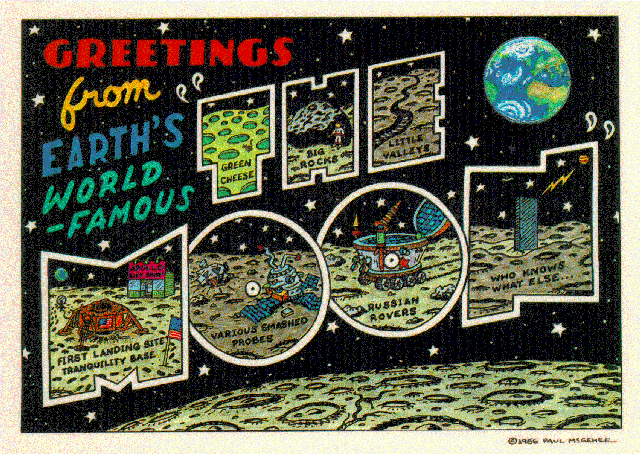

Moon:
The Moon is a large body that orbits planet Earth, being Earth's only permanent natural satellite. It is the fifth-largest natural satellite in the Solar System, and the largest among planetary satellites relative to the size of the planet that it orbits (its primary). Following Jupiter's satellite Io, the Moon is second-densest satellite among those whose densities are known.
The Moon has fascinated mankind throughout the ages. By simply viewing with the naked eye, one can discern two major types of terrain: relatively bright highlands and darker plains. By the middle of the 17th century, Galileo and other early astronomers made telescopic observations, noting an almost endless overlapping of craters. It has also been known for more than a century that the Moon is less dense than the Earth. Although a certain amount of information was ascertained about the Moon before the space age, this new era has revealed many secrets barely imaginable before that time. Current knowledge of the Moon is greater than for any other solar system object except Earth. This lends to a greater understanding of geologic processes and further appreciation of the complexity of terrestrial planets.
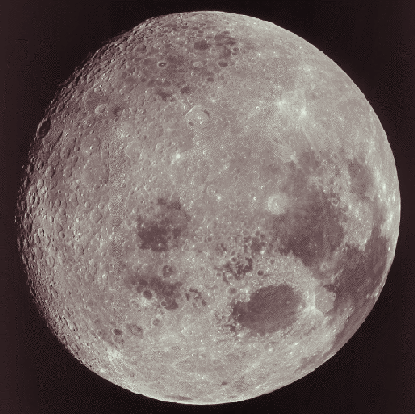
The Moon is 384,403 kilometers (238,857 miles) distant from the Earth. Its diameter is 3,476 kilometers (2,160 miles). Both the rotation of the Moon and its revolution around Earth takes 27 days, 7 hours, and 43 minutes. This synchronous rotation is caused by an unsymmetrical distribution of mass in the Moon, which has allowed Earth's gravity to keep one lunar hemisphere permanently turned toward Earth (tidal locking). The above full disc of the Moon was photographed by the Apollo 17 crew during their trans-Earth coast homeward following a successful lunar landing mission in December 1972. Mare seen on this photo include Serentatis, Tranquillitatis, Nectaris, Foecunditatis and Crisium.
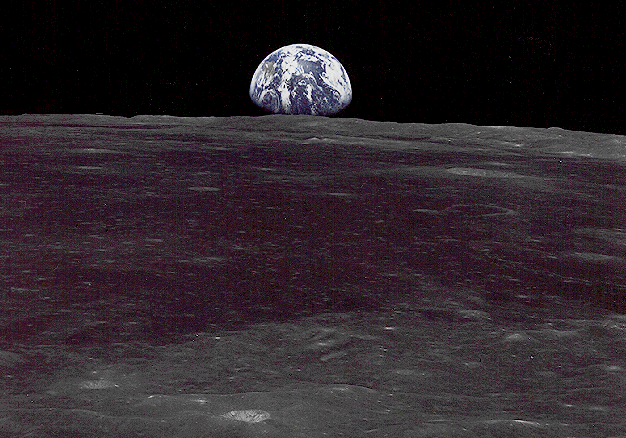
This image shows Earthrise over the Moon's limb, also taken by an Apollo mission. The Soviet Union's Luna programme was the first to reach the Moon with uncrewed spacecraft in 1959; the United States' NASA Apollo program achieved the only crewed missions to date, beginning with the first crewed lunar orbiting mission by Apollo 8 in 1968, and six crewed lunar landings between 1969 and 1972, with the first being Apollo 11. These missions returned over 380 kg (840 lb) of lunar rocks, which have been used to develop a geological understanding of the Moon's origin, the formation of its internal structure, and its subsequent history. Since the Apollo 17 mission in 1972, the Moon has been visited only by uncrewed spacecraft.
The principal modern English adjective pertaining to the Moon is lunar, derived from the Latin Luna. A less common adjective is selenic, derived from the Ancient Greek Selene, from which is derived the prefix "seleno-" (as in selenography).
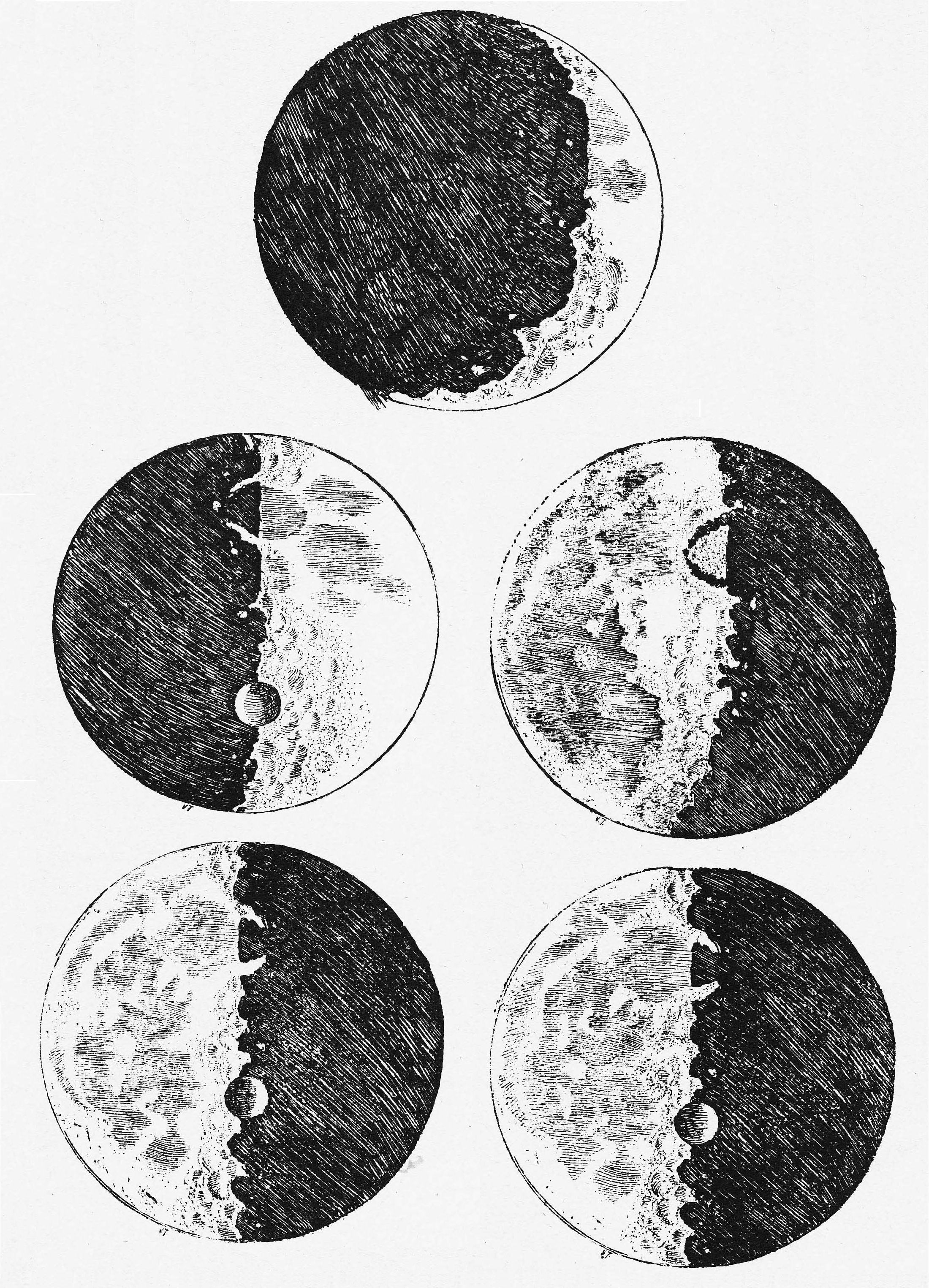
In 1609, Galileo Galilei drew one of the first telescopic drawings of the Moon in his book Sidereus Nuncius and noted that it was not smooth but had mountains and craters.

Above is what the lunar surface was thought to look like in the 1800's, it represents a historical concept of the lunar surface appearance. Robotic missions to the Moon later demonstrated that the surface features are much more rounded due to a long history of impacts.
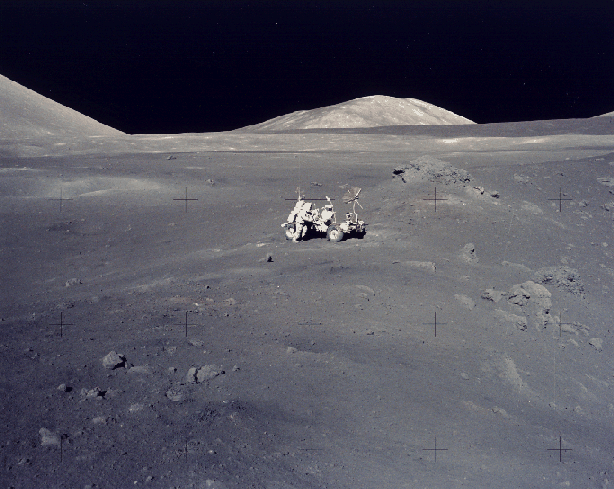
Now we know the lunar surface looks like the above image taken from the Apollo missions.
Many people have also seen imaginary faces on the Moon such as the Man on the Moon, the Lady on the Moon and the Bunny on the Moon.

Above is a movie of lunar rotation taken from the Clementine mission in 1994. Notice how the farside of the Moon does not have the large, smooth-looking maria that the nearside has.
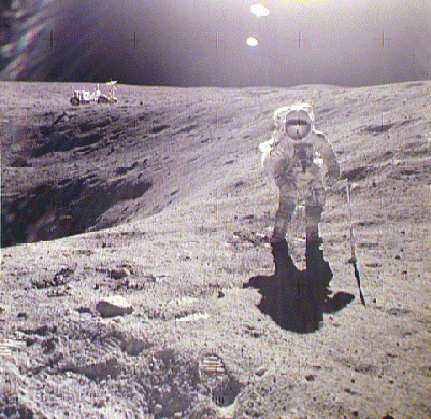
The most obvious feature on the Moon is its many craters, due to impacts by space debris onto the surface. An Apollo 16 astronaut stands near the rim of Plum Crater (30m, or over 200 yards, in diameter).
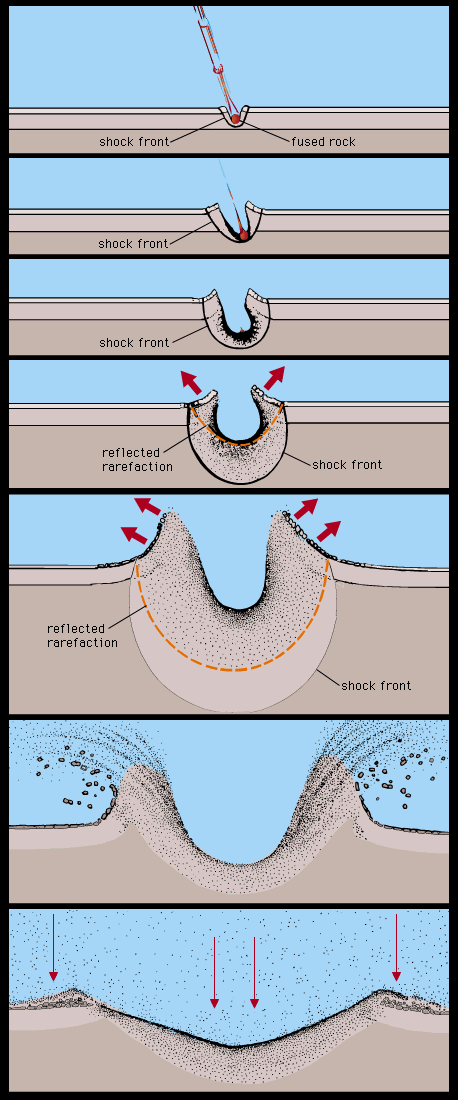
A major geologic process that has affected the Moon's surface is impact cratering, with craters formed when asteroids and comets collide with the lunar surface. There are estimated to be roughly 300,000 craters wider than 1 km (0.6 mi) on the Moon's near side alone. The lunar geologic timescale is based on the most prominent impact events, including Nectaris, Imbrium, and Orientale, structures characterized by multiple rings of uplifted material, between hundreds and thousands of kilometres in diameter and associated with a broad apron of ejecta deposits that form a regional stratigraphic horizon. The lack of an atmosphere, weather and recent geological processes mean that many of these craters are well-preserved.
Blanketed on top of the Moon's crust is a highly comminuted (broken into ever smaller particles) and impact gardened surface layer called regolith, formed by impact processes. The finer regolith, the lunar soil of silicon dioxide glass, has a texture resembling snow and a scent resembling spent gunpowder. The regolith of older surfaces is generally thicker than for younger surfaces: it varies in thickness from 10-20 km in the highlands and 3-5 km in the maria. Beneath the finely comminuted regolith layer is the megaregolith, a layer of highly fractured bedrock many kilometres thick. Although Earth has experienced many meteorite impacts throughout its history, the action of wind and water quickly erases the resulting craters.
Earth-Moon system:
The Earth-Moon system forms one of the lowest ratios of primary to secondary diameters in the Solar System. The ratio of Earth to Lunar diameter is 3.6 to 1. For comparison, the next lowest is Saturn and its largest moon, Titan, with a ratio of 25 to 1. The Earth-Moon system is special in this regard and has an impact on the evolution of life.
Surface features:
The major surface features on the Moon are craters, highlands and maria.

craters

highlands
The most distinctive aspect of the Moon is the contrast between its bright and dark zones. Lighter surfaces are the lunar highlands, which receive the name of terrae (singular terra, from the Latin for Earth), and the darker plains are called maria (singular mare, from the Latin for sea), after Johannes Kepler who introduced the name in the 17th century. The highlands are anorthositic in composition, whereas the maria are basaltic. The maria often coincide with the "lowlands," but it is important to note that the lowlands (such as within the South Pole-Aitken basin) are not always covered by maria. The highlands are older than the visible maria, and hence are more heavily cratered.

maria
The major products of volcanic processes on the Moon are evident to Earth-bound observers in the form of the lunar maria. These are large flows of basaltic lava that correspond to low-albedo surfaces covering nearly a third of the near side. Only a few percent of the farside has been affected by mare volcanism. Even before the Apollo missions confirmed it, most scientists already thought that the maria are lava-filled plains, because they have lava flow patterns and collapses attributed to lava tubes.
The ages of the mare basalts have been determined both by direct radiometric dating and by the technique of crater counting. The oldest radiometric ages are about 4.2 Gyrs, whereas the youngest ages determined from crater counting are about 1 Gyrs (1 Gyrs = 1 billion years). Volumetrically, most of the mare formed between about 3 and 3.5 Gyrs before present. The maria are clearly younger than the surrounding highlands given their lower density of impact craters.
The minor features are:
1) wrinkle ridges
2) scarps
3) domes
4) rilles
Craters:
The typical features to an impact crater are shown below:


Normal, round craters are due to impacts from objects up to a couple thousand meters. Object larger (asteroids) will typically crack the crust and form impact basins.
Erosion is slow on a world without an atmosphere and is caused by:
1) slumping (gravity)
2) other impacts
3) temperature changes
4) moonquakes
The result is that young craters have sharp edges (usually less than 2x108 years old) and old craters are rounded, smoother (with ages of order a billion years old).
Highlands:
The lighter colored, heavily cratered regions are called the lunar highlands. The bare, chaotic terrain indicates that these regions are primordial and one would expect the oldest rocks in these regions. Mountains on the Moon are not due to tectonic activity, but rather are due to overlapping impact rims.
Maria:
Dark-colored regions which turn out to be smooth plains of basaltic lava. They are the remnants of large impact events that cracked the crust and allowed the lava from the mantle to flow upward and erase early cratering. Note that the impacts must have occurred after the initial phase of cratering.
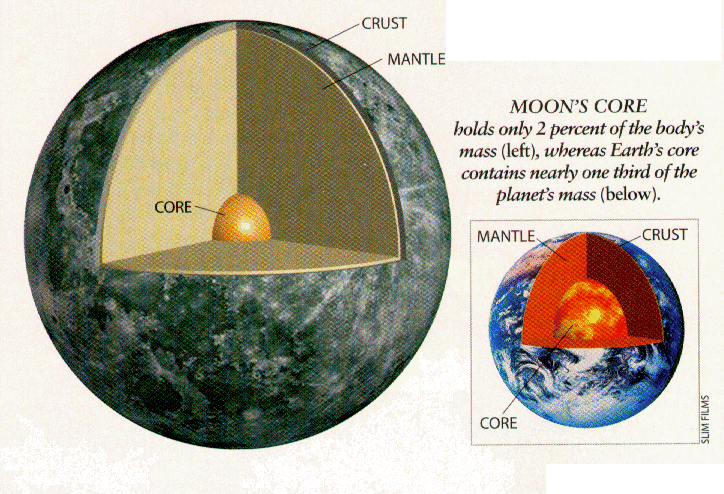
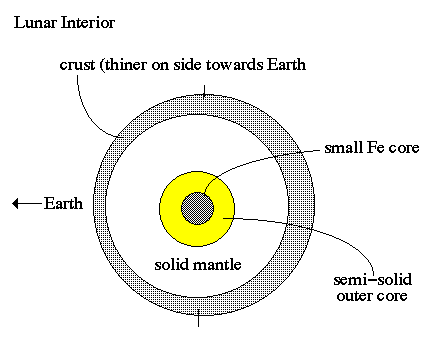
All the maria are on the nearside of the Moon, none on the farside. This is due to the fact that the nearside crust is thinner than the farside crust (easier to penetrate by impacts). The crust is thinner on the nearside due to tidal interaction with the Earth during the formation epoch.
Lunar Soil:
The lunar soil is a fine grained, cohesive sand/gravel containing glass spheres (impact ejecta), igneous dust and coarse breccia (cemented material from impacts).

Soil from the maria are 3 to 4x109 years old. Soil from the highland is 4.6x109 years old (from the early Solar System).
The soil composition for the Moon is similar to Earth soil but with very different element ratios. In particular, the lunar soil is rich in refractory elements (i.e. ones with high boiling points) and low in volatile elements (i.e. ones with low boiling points). The conclusion is that the Moon was formed from hotter materials than the Earth.
Apollo Lunar Program
The effort to put men on the Moon was modivated by a patriotic/panicked reaction to the USSR launch of Sputnik in 1957, i.e. it was initially a political goal. The early space program was unique in that it represented leadership from the highest levels of government on down, with unpresendented support from Congress. While the motivation was political, careful attention to the science goals were maintained. Those were
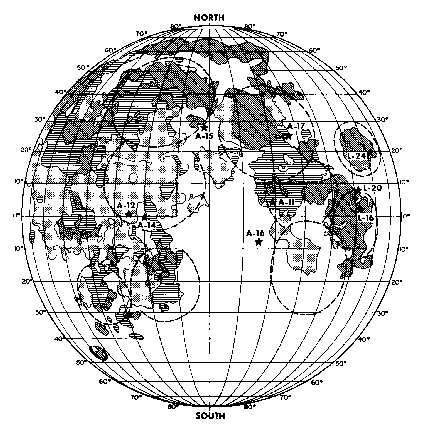
Altogether there were 6 landings on the Moon. The first three (Apollo's 11,12,14) returned lunar samples that were extremely local to the landing site (no one wanted to wander too far away from the lander vehicle). The last three (Apollos 15,16,17) took a dune buggy with them and drove around the lunar surface in order to perform more extensive sampling.
From the analysis of returned lunar samples, the following sequence of events regarding the geological history of the Moon have been determined:
The age dating of the lunar rocks have allowed us to identify four distinct periods in its geological history:
Origin of the Moon:
The Moon has long been an anamoly because its mass compared to the earth is 1/80 and there is very large for a planetary satellite
Possibilities for Lunar Origin:
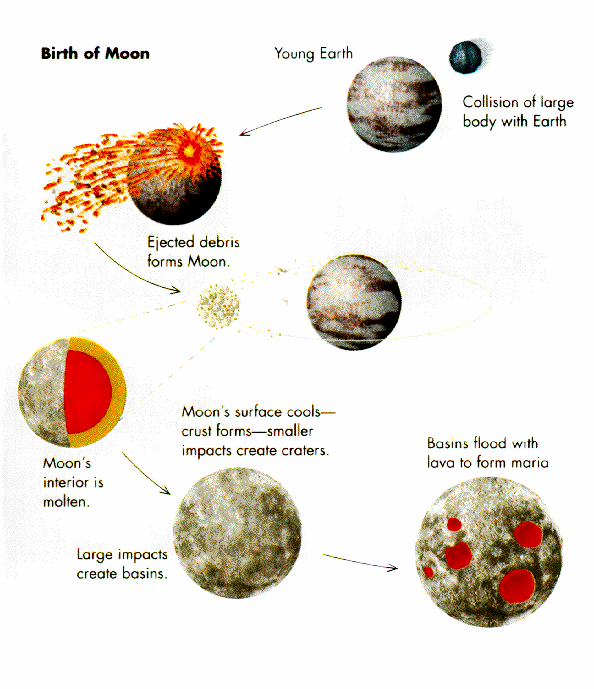
Note that the Moon forms from Earth mantle material, which is low in density around 3 or so.
Since the Moon formed from the condensation of a debris ring in relatively near-earth orbit, the Moon was initially quite close to the earth. At this time (4.6 billion years ago) the earth was rotating quite rapidly (about once every 5 hours). The nearby Moon exerted large tidal forces on the spinning earth causing it to slow down. This process continues to day. To conserve total system angular momentum, the response of the Moon is then to move farther away from the earth.
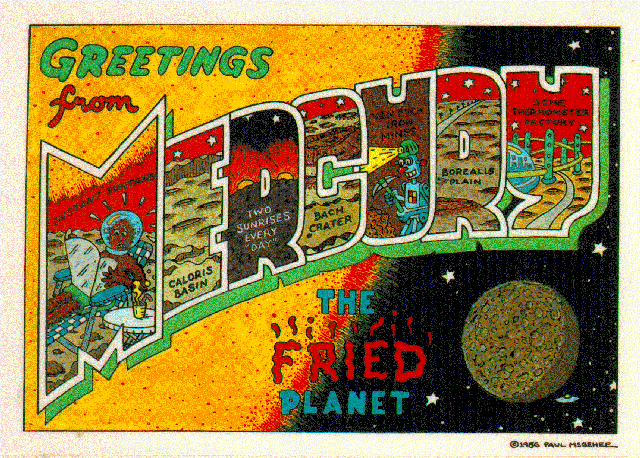
Mercury:
Mercury is the smallest (a radius of only 2440 km or 1590 miles) and innermost planet in the Solar System. Its orbital period around the Sun is 88 days and is the shortest of all the planets in the Solar System. It is named after the Roman deity Mercury, the messenger to the gods. Since it is the closest planet to the Sun its greatest elongation is only 28 degrees (i.e. its only visible right after sunset or right before sunrise). Since it is located near the Sun at sunrise or sunset, the ancients thought that Mercury was two different planets, Lucifer and Hermes. Two spacecraft have visited Mercury: Mariner 10 flew by in 1974 and 1975; and MESSENGER, launched in 2004, orbited Mercury over 4,000 times in four years before exhausting its fuel and crashing into the planet's surface on April 30, 2015.
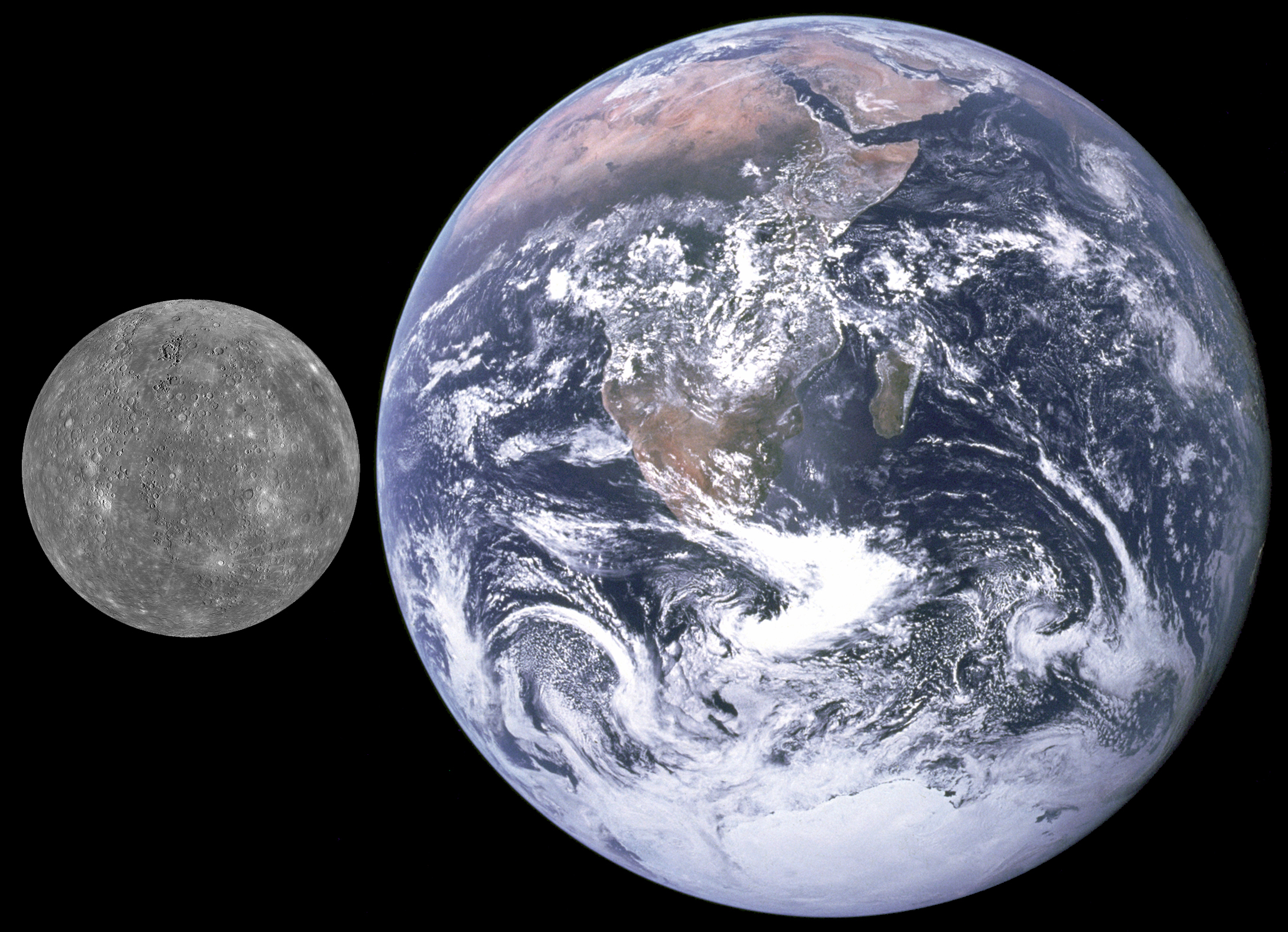
From its radius (i.e. volume) and mass we calculate it has a mean density of 5.4 g/cm3 which implies a dense iron (Fe) core. All planets form as molten balls, then cool and solidify. The cooling rate is proportional to the amount of material (the planet's mass) and its surface area (its radius). Since Mercury is low in mass (less heat stored from formation), its core is probably solid rather than liquid.
The rotation period of Mercury is 58.6 days and its orbital period (year) is 87.9 days. Notice that 2/3 times 87.9 is 58.6; thus, Mercury suffers from spin-orbit coupling where the tidal forces from the Sun has locked Mercury's rotation into a resonance number (1/2, 2/3, 4/5, 5/6, etc...).

Daytime temperatures on the surface of Mercury hover around 700 degrees Kelvin (enough to melt lead). Whereas, at night the ground temperature plunge to a mere 100 Kelvins (air turns to liquid at 77 Kelvins). Dawn is ten times more brilliant than on the Earth, since the Sun is ten times larger. The lack of any significant atmosphere means that before dawn you can see the Sun's corona spreading over the horizon. On the dark side of the planet, temperatures average 110 K.
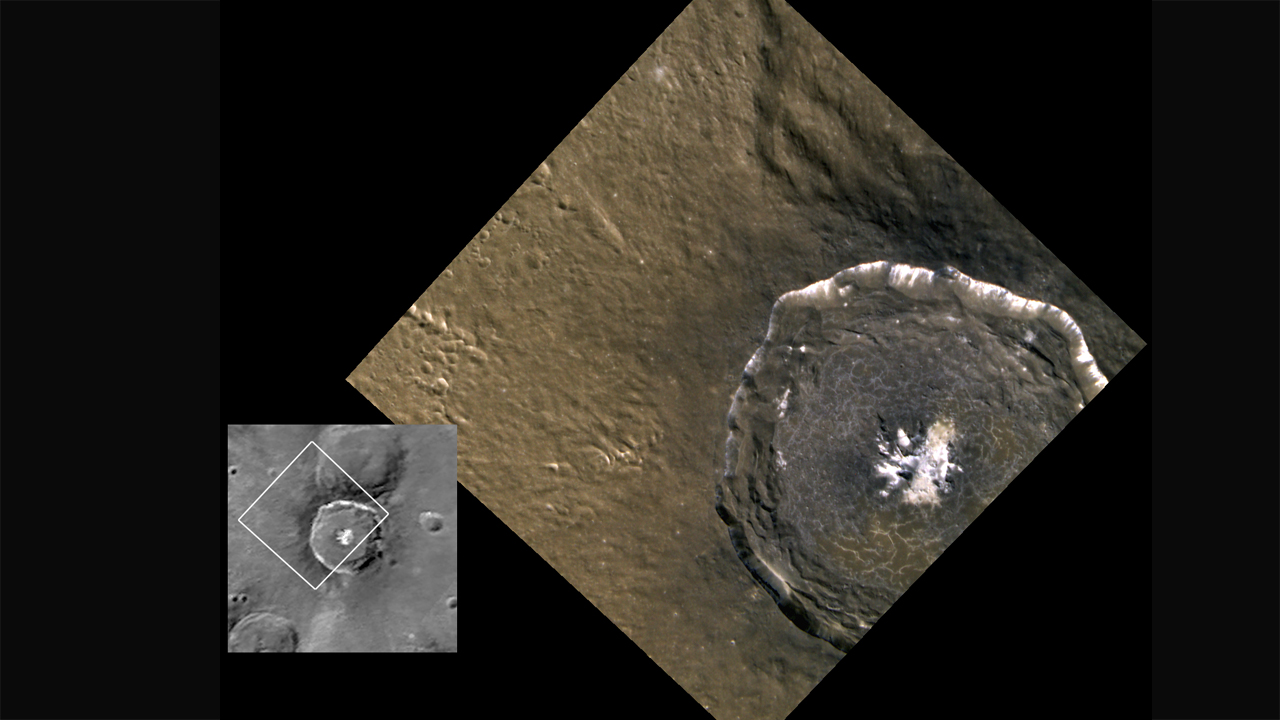
Although the daylight temperature at the surface of Mercury is generally extremely high, observations strongly suggest that ice (frozen water) exists on Mercury. The floors of deep craters at the poles are never exposed to direct sunlight, and temperatures there remain below 102 K; far lower than the global average. Water ice strongly reflects radar, and observations by the 70-meter Goldstone Solar System Radar and the VLA in the early 1990s revealed that there are patches of high radar reflection near the poles. Although ice was not the only possible cause of these reflective regions, astronomers think it was the most likely.
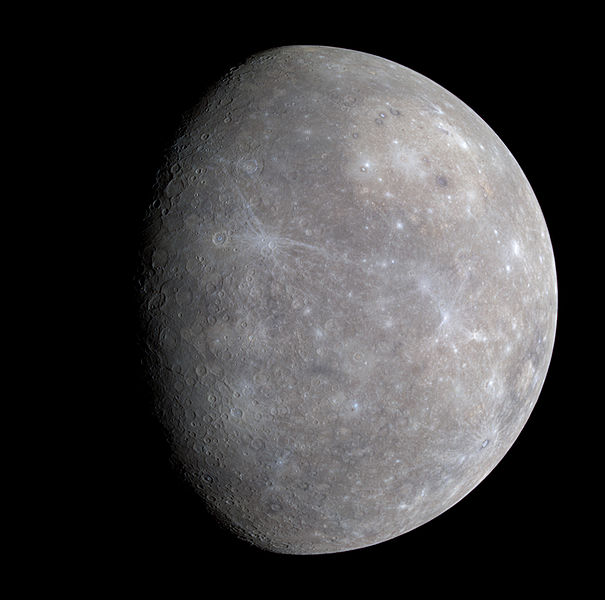
The above image is of Mercury from the Messenger mission (2008) The north pole is at the top and the equator extends from left to right about two-thirds down from the top. Bright rayed craters are prominent in this view of Mercury. One such ray seems to join in both east-west and north-south directions.
Mercury's surface is similar in appearance to that of the Moon, showing extensive mare-like plains and heavy cratering, indicating that it has been geologically inactive for billions of years. Albedo features are areas of markedly different reflectivity, as seen by telescopic observation. Mercury has dorsa (also called "wrinkle-ridges"), Moon-like highlands, montes (mountains), planitiae (plains), rupes (escarpments), and valles (valleys).
Names for features on Mercury come from a variety of sources. Names coming from people are limited to the deceased. Craters are named for artists, musicians, painters, and authors who have made outstanding or fundamental contributions to their field. Ridges, or dorsa, are named for scientists who have contributed to the study of Mercury. Depressions or fossae are named for works of architecture. Montes are named for the word "hot" in a variety of languages. Plains or planitiae are named for Mercury in various languages. Escarpments are named for ships of scientific expeditions. Valleys or valles are named for radio telescope facilities.
Mercury was heavily bombarded by comets and asteroids during and shortly following its formation 4.6 billion years ago, as well as during a possibly separate subsequent episode called the Late Heavy Bombardment that ended 3.8 billion years ago. During this period of intense crater formation, Mercury received impacts over its entire surface, facilitated by the lack of any atmosphere to slow impactors down. During this time Mercury was volcanically active; basins such as the Caloris Basin were filled by magma, producing smooth plains similar to the maria found on the Moon.
Data from the October 2008 flyby of MESSENGER gave researchers a greater appreciation for the jumbled nature of Mercury's surface. Mercury's surface is more heterogeneous than either Mars's or the Moon's, both of which contain significant stretches of similar geology, such as maria and plateaus.
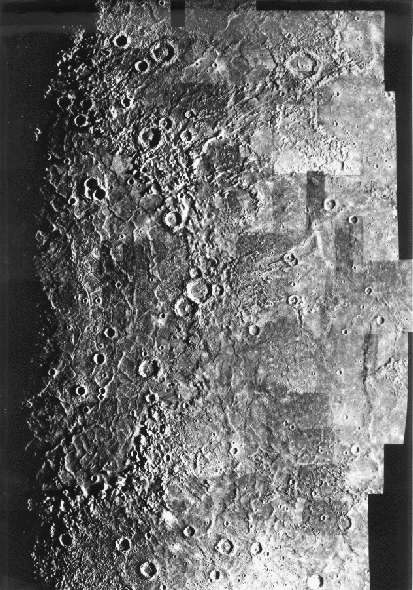
The above mosaic shows the Caloris Basin (located half-way in shadow on the morning terminator). Caloris is Latin for heat and the basin is named this because it is near the subsolar point (the point closest to the sun) when Mercury is at aphelion. Caloris Basin is 1,300 kilometers (800 miles) in diameter and is the largest know structure on Mercury. It was formed from an impact of a projectile with asteroid dimensions. The interior floor of the basin contains smooth plains but is highly ridged and fractured. North is towards the top of this image.
There are two geologically distinct plains regions on Mercury. Gently rolling, hilly plains in the regions between craters are Mercury's oldest visible surfaces, predating the heavily cratered terrain. These inter-crater plains appear to have obliterated many earlier craters, and show a general paucity of smaller craters below about 30 km in diameter. The so-called "Weird Terrain" formed at the point antipodal to the Caloris Basin impact.
Smooth plains are widespread flat areas that fill depressions of various sizes and bear a strong resemblance to the lunar maria. Notably, they fill a wide ring surrounding the Caloris Basin. Unlike lunar maria, the smooth plains of Mercury have the same albedo as the older inter-crater plains. Despite a lack of unequivocally volcanic characteristics, the localisation and rounded, oblate shape of these plains strongly support volcanic origins. All the smooth plains of Mercury formed significantly later than the Caloris basin, as evidenced by appreciably smaller crater densities than on the Caloris ejecta blanket. The floor of the Caloris Basin is filled by a geologically distinct flat plain, broken up by ridges and fractures in a roughly polygonal pattern. It is not clear whether they are volcanic lavas induced by the impact, or a large sheet of impact melt.
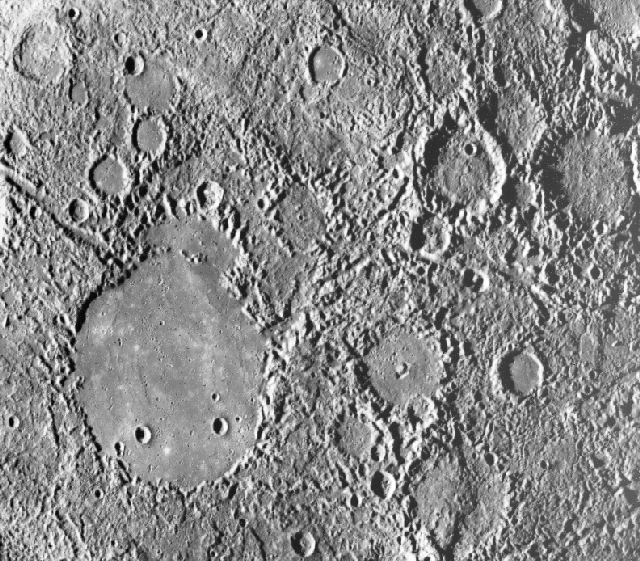
The above ``weird terrain'' best describes this hilly region of Mercury. This area is at the antipodal point from the large Caloris basin. The shock wave produced by the Caloris impact was reflected and focused to this antipodal point, thus jumbling the crust and breaking it into a series of complex blocks. The area covered is about 100 kilometers (62 miles) on a side.
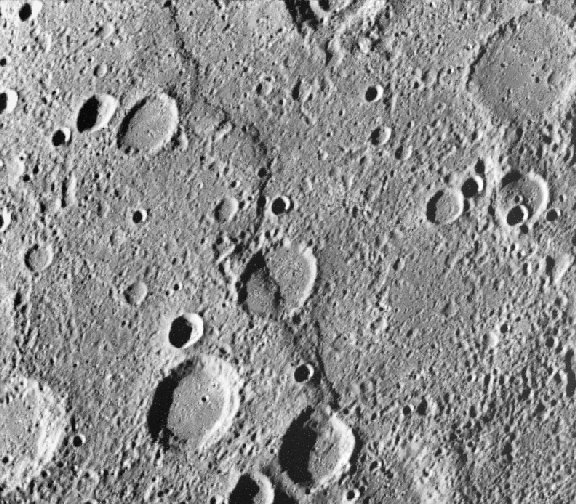
The above picture is a Mariner 10 image shows Santa Maria Rupes, the sinuous dark feature running through the crater at the center of this image (note how is passes through the crater rim indicating that it was created after the impact crater). Many such features were discovered in the Mariner images of Mercury and are interpreted to be enormous thrust faults where part of the mercurian crust was pushed slightly over an adjacent part by compressional forces.
As Mercury's interior cooled, it contracted and its surface began to deform, creating wrinkle ridges and oblate scarps associated with thrust faults. The scarps can reach lengths of 1000 km and heights of 3 km. These compressional features can be seen on top of other features, such as craters and smooth plains, indicating they are more recent. Mapping of the features has suggested a total shrinkage of Mercury's radius in the range of ~1 to 7 km. Small-scale thrust fault scarps have been found, tens of meters in height and with lengths in the range of a few km, that appear to be less than 50 million years old, indicating that compression of the interior and consequent surface geological activity continue to the present.
Surface features:
In general, the surface of Mercury is similar to the Moon (i.e. heavily cratered due to a lack of a heavy atmosphere to erode away primordial impacts). However, there are some key differences:
1) There are few maria on Mercury and they are small. No large impact era like the Moon. Therefore, Mercury must have cooled faster.
2) Cratering is less heavy, more plain region between craters. Due to the higher surface gravity on Mercury (you weight more than on Mercury than the Moon). This means impacts did not throw debris as far, fewer secondary craters and more concentrated around primary crater.
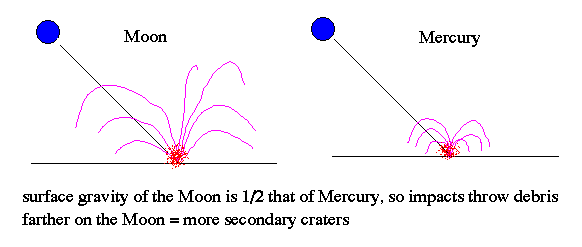

Mercury's Magnetic Field:
Although Mercury has a high density, implying it is rich in iron (Fe), almost no Fe is detected by spectroscopy of its surface. Thus, most of the Fe must has sunk into the core while Mercury was young and molten. And, that it must have stayed in a molten state for much longer than the other planets formed at the same time.

Mercury's strong magnetic field also gives it a very weak atmosphere. Planet's as hot as Mercury quickly lose their atmosphere's as the high temperatures heat the atmosphere molecules to escape velocity. However, Mercury is very close to the Sun and is able to capture some of the Sun's solar wind (composed of protons and electrons) in its magnetic field, giving it a very thin and tenuous atmosphere.

|
|

|